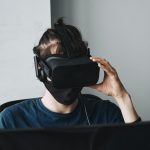Data in VR training
Data is one of the most increasingly valued commodities in our current world of fast flowing knowledge. In a nutshell, data is information about various types of things, including people, activities, events etc. For any business, data is very valuable in order to make adequate organisational decisions. The same goes for learning. When it comes to learning, data and feedback is valuable in order to analyse and improve the learning modules as well as learner methods. With good quality and reliable data, businesses and training companies can upgrade and enhance training modules and training styles to fit the personality and reactions of employees who undergo training. This enables a well-suited training experience and better outcomes leading to successful training results.
VR Analytics To Enhance Learning
VR analytical data leads to calculated improvements and adaptive learning. VR training data also helps L&D keep track of training for individual employees adjusting the training along the way to better align with personal needs and requirements. When it comes to analytics, a study by Deloitte shows that 49% of responders prefer analytics as it helps them make good decisions and 10% said it improves their relationships with co-workers and customers.
VR training headsets have the capacity to store data which can be transferred to an analytical tool to measure and analyze the data further. This is a major advantage VR training holds over its counterparts of classroom and e- learning. Such data can show effectiveness of the training as well as areas requiring improvement.
Data can be utilised in the following ways:
Attention and Focus
VR headsets use technology to gather and understand how the user paid attention to the training. Number of times it took to grasp the training and replaying training can be kept track of to understand the learner and accordingly adjust training styles to fit their needs.
Verbal Cues
VR technology has voice recognition and recording which can be analyzed. Keeping track of this allows companies to look into the emotional responses of learners to avatars and situations put forth in VR simulations while also recording their pace, sentiment and pauses. This can help learners improve and understand their communication as well as the understanding of their reactions to the training situation.
Body Language
Collection of this data helps the trainee understand their body language and positioning during the training. It is essential to know whether you are placed correctly during the simulation, looking at the right things and acting in appropriate manner, especially in hazard safety training scenarios. Body language data also helps training companies understand if their simulation is helpful for the learner and helps fix erratic and unnatural simulations scenarios.
Retinal Eye Tracking
With 360° viewing and experiencing expansive life-like scenarios in virtual reality, it is common to miss out on information and perhaps concentrate. Hence, tracking eye movements and attention of learners is helpful in determining whether the training is making the right impact. This can be done at any point during the program by making ‘heat maps’ of eye movements.
Biometric Feedback
This data feedback in VR training is very extensive and detailed as it can track heart rate, stress levels and brain activity of the learner experiencing the training to understand the nature of the learner’s experience in the simulation. This can be used to understand the learner’s responses to learning and whether the learning is appropriately absorbed.
Data Security and Ethical considerations
L&D departments value data and put analytics in high regards when it comes to training and growth of employees. Information gathered through VR headsets is personal and sensitive to an extent where it reads brain activities and eye movements and is tied to individual learners. Naturally such information is highly confidential and should be handled with care and ethical integrity. VR is among the few technologies that provide such a high level of access to a learner’s responses, as compared to traditional forms of learning where the evaluation is ordinary and superficial, VR training takes evaluation to a deeper level. Used correctly, such data helps build an inclusive, comprehensive VR training strategy for businesses.
If you want to learn more about how data can be used to measure the impact of learning, have a read of the blog post ‘Evaluation and Effectiveness of VR Soft Skills Training’.
Written by Simran Singh
Similar articles to check out:







